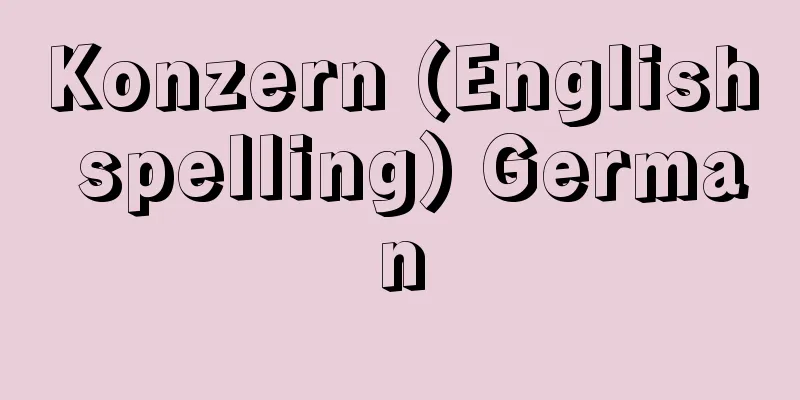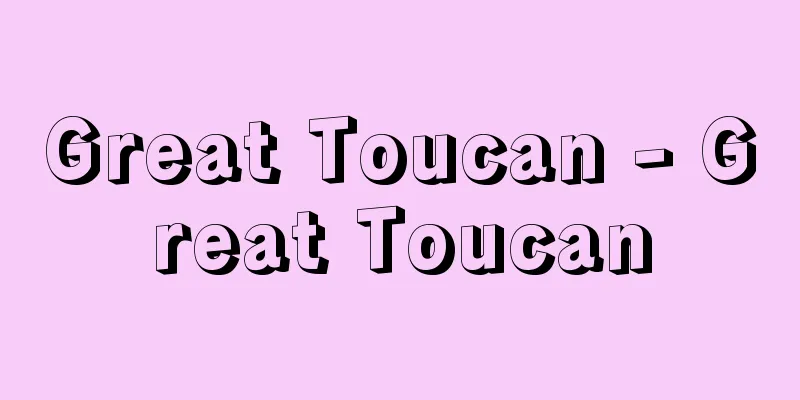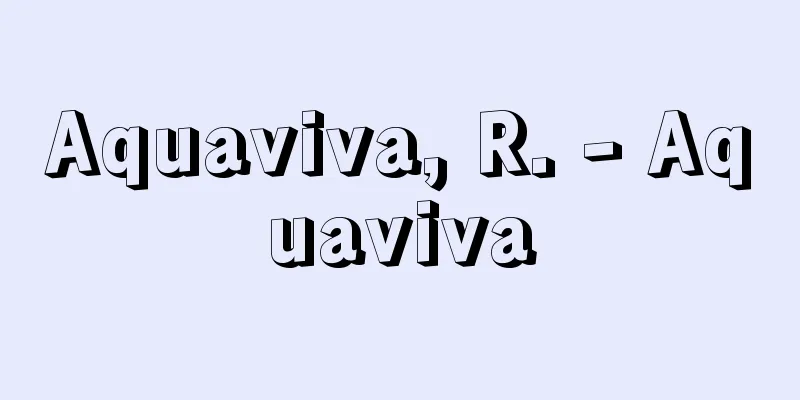Konzern (English spelling) German

|
A corporate merger is a type of comprehensive corporate group formed by the capital combination of many large companies in different industries. In the United States, this type of combination is known as an interest group. Japan's zaibatsu is also famous as the Japanese form of a conglomerate. Although a conglomerate is a capital combination, each member company legally retains the form of an independent legal entity, and is governed by means of stock ownership, loans, personnel combinations, etc. Based on the form of governance, it can be broadly divided into the following two types. (1) Conzern based on the holding company system In this type of conzern, a holding company is the center of integration to own and control the shares of the affiliated companies. Japan's zaibatsu were a typical example. In this case, the holding company can be a pure holding company or an operating holding company. The former is a holding company that does not operate any other business, while the latter is a holding company that operates other important businesses. Conzern based on a holding company has the advantage of clear and strong control and management, since it is a form of unified control of the affiliated companies, with the holding company at the center. In many cases, the headquarters, which is the holding company, has unified authority over the appointment and dismissal of employees of affiliated companies, important investments, and entry into new fields. However, on the other hand, since its activities as a comprehensive monopoly are clearly visible to the outside world, it is prone to criticism from the public. In addition, a tendency towards self-financing within the group arises, and functions for mobilizing and absorbing social capital, such as stock offerings and bank loans, become inadequate, and opportunities to widely search for managerial talent become insufficient. Therefore, as time progresses, this type of group tends to gradually move on to the next looser type. (2) Interest Group This type of conglomerate is common in the United States today, and is sometimes called a financial group. It is a corporate group in which the scope of the core of control and the affiliated companies is not clear, and complex relationships are maintained through mutual ownership of shares and interlocking directorates. Compared to conglomerates based on holding companies, it is more difficult for them to act as a unified management body, and the companies in the group strengthen their individuality, move to other groups, or form joint ventures with other groups, resulting in a fluid and complex structure. While antimonopoly policies have been strengthened, the industrial structure has changed due to the progress of technological change, and interest groups, which are flexible combinations, are easier to adapt to than conglomerates based on the rigid structure of holding companies, and there is a gradual tendency to move in this direction. Japanese corporate groups are a good example of the change from the rigid structure of zaibatsu conglomerates before the war to the more flexible interest group-like structure after the war. As can be inferred from the fact that the word "konzern" is originally German, many huge conglomerates were formed in Germany from the early 20th century onwards, including the famous Stinnes Konzern, the E.G. Farben Konzern in the chemical industry, the Krupp Konzern in the steel and arms industries, and the Mannesmann Konzern in the steel industry. These conglomerates were divided after World War II as part of the Allied powers' policy of dismantling monopolies, but with the recovery of the West German economy, many of them have been revived and reorganized. In America, interest groups are often looser associations than rigid structures such as conglomerates based on holding companies, but the concentration of economic power in huge groups such as the Morgan Group, the Rockefeller Group, the Mellon Group, and the Citibank Group stands out. In terms of their characteristics, there are financial groups centered around financial institutions such as the Morgan Group, and industrial conglomerates such as the Rockefeller Group centered around the Standard Oil Company. In this way, conglomerates, as comprehensive corporate combinations that control many large companies, wield great power that cannot be ignored in the modern economy. Of course, unlike horizontal combinations of companies in the same industry such as cartels and trusts, conglomerates are combinations of companies in different industries, and therefore do not in themselves have the character of a monopoly combination. However, the economic power of a large corporate group has collective might, and it exerts economic power that other individual companies do not. Therefore, the superior economic power of the group, such as capital power, technological development power, and market development power, puts pressure on individual companies in the market and gives it an advantage when entering new fields, giving it monopoly power as a so-called entry prevention force. In this way, conglomerates are considered the highest form of corporate combination, and in many cases they include numerous financial institutions such as banks and insurance companies, as well as large manufacturing companies, and are considered a concrete form of financial monopoly capital. However, in terms of how to prevent the harm caused when such huge and comprehensive economic power is exerted, there is no effective method of regulation under antitrust policy, and this is considered a future policy issue. [Misono students, etc.] "Hiromi Arisawa and Ryokichi Minobe (eds.), Complete Works of Economics 47 & 48: Cartels, Trusts, Conglomerates (1931, Kaizosha) " "Modern Corporate Forms Theory by Sadajiro Kamibayashi, Kiyoshi Inoue, and Soichiro Gigaya (1962, Minerva Shobo)" " The National Monopoly White Paper 2: Corporate Groups (eds.), Monopoly White Paper Committee of the Peace Economic Planning Council (1978, Ochanomizu Shobo)" [References] | | | |Source: Shogakukan Encyclopedia Nipponica About Encyclopedia Nipponica Information | Legend |
|
企業結合のうち、異なった業種に属する多数の大企業が資本的に結合した総合的な企業グループをいう。アメリカにおいては利益集団interest groupといわれる結合がこれにあたる。また、日本の財閥はコンツェルンの日本的形態として有名である。コンツェルンは資本的な結合体ではあるが、各所属企業は法律上は独立した法人企業の形態を保っており、これを株式所有、融資、人的結合などの方法により統括している。その統括の形態から大きく次の2種類に分けられる。 (1)持株会社方式によるコンツェルン 傘下の企業の株式を所有し、支配するための持株会社holding companyを統合の中心とするコンツェルンで、わが国の財閥はその典型であった。この場合の持株会社には純粋持株会社と事業持株会社とがある。前者は他に事業を営んでいない持株会社で、後者は他に有力な事業を営んでいる持株会社である。持株会社に基づくコンツェルンは、統括の中核である持株会社を中心として、傘下の企業を一元的に支配する形態であるから、その統制、管理が明確で強固であるという利点をもっている。多くの場合、持株会社である本社は、傘下企業の役職員の任免、重要な投資、新分野への進出などについて統一的な権限をもっている。しかしその反面、総合的な独占体としての活動が外部に明確に表れるので、世人の批判を受けやすい。また、コンツェルン内での自己金融的な傾向が生じ、株式の募集や銀行融資の受入れなど社会的資本を動員吸収する機能が不十分になったり、経営者としての人材を広く求める機会も十分でなくなる傾向が生ずる。したがってこの形態のコンツェルンは、時代の進展とともに、しだいに、よりルーズな次の形態に移る傾向が生ずる。 (2)インタレスト・グループ この方式のコンツェルンは現代アメリカに多い形態で、金融グループといわれる場合もある。支配の中核と所属企業の範囲が明確でなく、株式の相互所有、役員の兼任interlocking directoratesなどの方法によって複雑な結合関係を保った企業グループである。持株会社に基づくコンツェルンに比べると、統一した経営体としての行動をとりにくくなり、グループに属する企業が独自性を強めたり、他のグループに移動したり、または、他のグループとの共同支配企業が生ずるなど、流動的で複雑な構造をもっている。反独占政策が強化される一方、技術変革の進展による産業構造の変化によって、剛構造的な構造をもつ持株会社方式によるコンツェルンよりも、弾力的な結合体であるインタレスト・グループのほうが適応しやすく、しだいにこの方向へ移行する傾向が生じている。日本の企業集団は、戦前における剛構造的な財閥コンツェルンから、戦後、より柔軟なインタレスト・グループ的形態への変化を示した好例である。 本来、コンツェルンという語がドイツ語であることから推察されるように、20世紀初頭からのドイツにおいては、有名なスティンネス・コンツェルンをはじめ、化学工業のイー・ゲー・ファルベン・コンツェルン、鉄鋼・兵器工業のクルップ・コンツェルン、鉄鋼産業のマンネスマン・コンツェルンなど多数の巨大コンツェルンの形成をみた。これらのコンツェルンは、第二次大戦後、連合国の独占解体政策によって分割されたが、西ドイツ経済の復興に伴い、多くのコンツェルンが復活再編成されるに至っている。 アメリカにおいては、持株会社に基づくコンツェルンなどのような剛構造体よりも、より緩やかな結合体としてのインタレスト・グループの形態をとっている場合が多いが、モルガン・グループ、ロックフェラー・グループ、メロン・グループ、シティバンク・グループなど巨大グループによる経済力集中が際だっている。その性格からいうと、モルガン・グループのような金融機関を中心とした金融グループと、スタンダード系石油会社を中心とするロックフェラー・グループのように産業コンツェルンの性格を有するものとがある。 このように、コンツェルンは、多数の巨大企業を支配する総合的企業結合体として、現代経済において無視することのできない大きな力をもっている。もちろん、カルテルやトラストなど同業種に属する企業の水平的結合と異なり、異業種間企業の結合体であるから、それ自体が独占的結合としての性格をもっているわけではない。しかし、巨大な企業グループとしての経済力は、集合的な威力を有し、他の単独企業にはない経済的実力を発揮する。したがって、そのグループとしての資本力、技術開発力、市場開拓の力などの優越した経済力は、市場において単独企業を圧迫したり、新分野への進出についてもより有利となるなど、いわゆる参入阻止力としての独占力を有している。 このように、コンツェルンは企業結合の最高の形態とされ、銀行や保険会社など金融機関や、巨大な製造会社を多数擁している場合が多く、金融独占資本の具体的形態とされる。しかし、その巨大で総合的な経済力が発揮される場合の弊害をいかに防止するかの面においては、独占禁止政策上、有効な規制方法がなく、今後の政策上の課題とされている。 [御園生等] 『有沢広巳・美濃部亮吉編『経済学全集47・48 カルテル・トラスト・コンツェルン』(1931・改造社)』▽『上林貞治郎・井上清・儀我壮一郎著『現代企業形態論』(1962・ミネルヴァ書房)』▽『平和経済計画会議独占白書委員会編『国民の独占白書2 企業集団』(1978・御茶の水書房)』 [参照項目] | | | |出典 小学館 日本大百科全書(ニッポニカ)日本大百科全書(ニッポニカ)について 情報 | 凡例 |
Recommend
Pyrrophyta
…They grow in both marine and inland waters, and ...
primary amenorrhea
…Some scholars explain that menarche occurs when ...
Liquid Helium I - Liquid Helium I
… Liquid 4He , or liquid helium-4, transitions to...
Lake Biwa
A fault-caused lake in the center of Shiga Prefec...
Battal Gazi
A Turkish heroic tale. Based on the story of Abd A...
Tadamasa Taira
Year of death: July 28, 1156 (August 15, 1156) Yea...
Yoshino Sakuzo
Political scientist. Theoretical leader of Taisho...
Lenten rose (English spelling)
...It is named after the fact that it blooms in w...
Hajime Tanabe
Philosopher. Born in Tokyo. Graduated from the De...
Sueyasu Ijichi
1782-1867 A samurai from the late Edo period. Bor...
intermediate products
…In addition, oil consumed by households for heat...
Interference colour
When interference is caused by monochromatic light...
Gambling - Noriyumi
An Imperial Court event held on the 18th of the Ne...
Joban Expressway - Joban Expressway
This expressway connects the Tokyo metropolitan a...
King Kashyapa
…Jammu and Kashmir is also famous as a tourist de...









